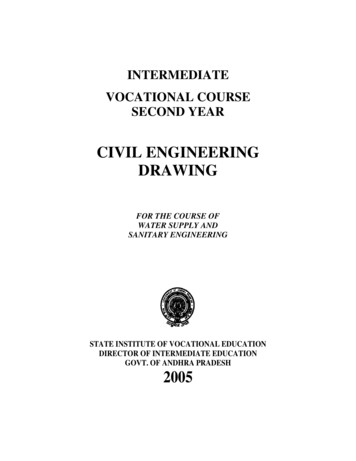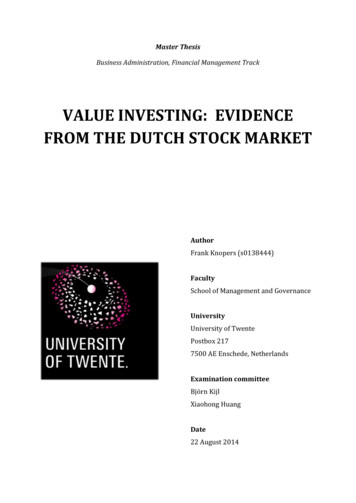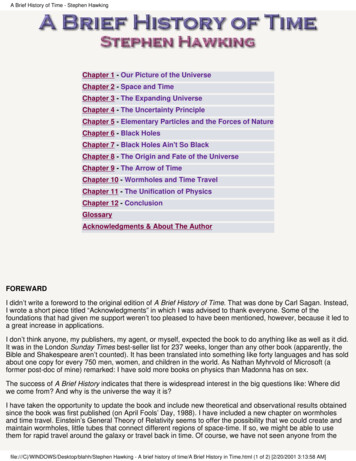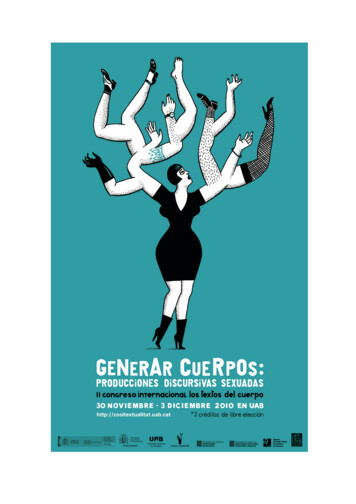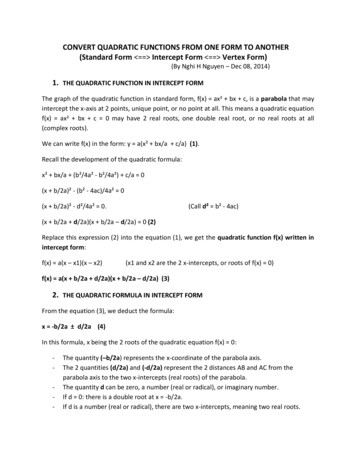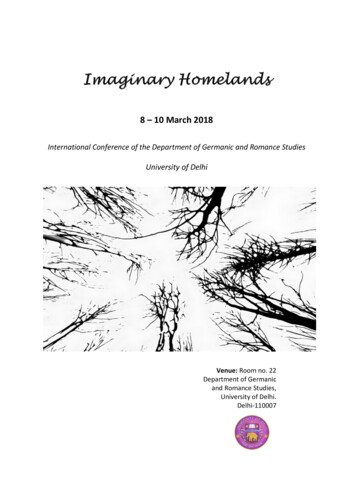
Transcription
Imaginary Homelands8 – 10 March 2018International Conference of the Department of Germanic and Romance StudiesUniversity of DelhiVenue: Room no. 22Department of Germanicand Romance Studies,University of Delhi.Delhi-110007
Imaginary HomelandsInternational Conference of the Department of Germanic and Romance Studies, University of Delhi8 – 10 March 2018In his essay Imaginary Homelands ("Imaginary Homelands" -- "Essays and Criticism 1981-1991")Salman Rushdie voices the political and cultural plight of the migrant and of the writer as an exile,migrant or expatriate in particular. The latter creates from fragments of memory, akin to the brokenmirror which may actually be as valuable as the ones supposedly unflawed, an Imaginary Homeland.If this Imaginary Homeland exists due to the migrant -- whether from one country to another, fromone language or culture to another or even from a traditional rural society to a modern metropolis—then in contemporary times the idea of a homeland is increasingly becoming inhabited inimagination.While on the sub-continent the exigencies of imperialism and capitalism rendered more than 5million humans homeless in the first half of the twentieth century, during the same time Europewitnessed a high scale of exile and homelessness due to the fascist ideologies of the ruling regimes.Homeland as a trope in the printed and visual text has followed trajectories that evolved in context tothe notion of the nation and the nation-state since the rise of Modern Europe. Since then in Europenational boundaries have repeatedly changed, with the European Union substantively reducing thetraditional significance of national boundaries and engendering a pan European identity.However, most of the erstwhile colonies of the West, where according to Benedict Anderson thenation and nationalism developed in context to colonialism, are markedly grappling to cement thecontours of the nation state and confer a national identity to their people. Both these developments,despite their differences challenge the established concepts of the homeland.A place called home with its ideal of a fixed, rooted space is also being redefined by the waves ofmigration from homeland to homeland in the wake of the contemporary forms of globalization. Thephilosopher, Vilém Flusser, raises questions about the viability of ideas of national identity in a worldwhose borders are becoming increasingly arbitrary and permeable. Flusser argues that modernsocieties are in flux, with traditional linear epistemologies being challenged by global circulatorynetworks and a growth in visual stimulation. The resultant nomadism, rootlessness and homelessnessfurther contribute to the homeland becoming an increasingly imagined space.The idyllic, pastoral homestead of the farmer, the bourgeois sentimental celebration of the nation,the ideologies of homeland demonising the Other and the recent habitat of humans in the virtualworld, have all been articulated in the various genres of literature, film, painting, sculpture, music aswell as in the theories of Space, State, Nation, Empire, Entangled Histories, Cosmopolitanism, Culture,Migration and Exile Studies.The conference aims to provide space for a nuanced engagement with the idea of Homeland, imaginedor real, from its inception to its current manifestations across multiple literary and culturalformulations.
Imaginary HomelandsInternational Conference of the Department of Germanic and Romance Studies, University of Delhi8 – 10 March 2018PROGRAMME10:00-10:1510:15-10:45Thursday, 8th March 2018Introductory RemarksShashwati MazumdarUniversity of DelhiKeynote AddressPrabhu MahapatraUniversity of Delhi10:45-11:15TEA/COFFEE BREAK11:15-12:45Panel 1Carola HilmesGoethe-UniversitätFrankfurtP K Yasser ArafathUniversity of DelhiSugata NandiWest Bengal StateUniversityChair: Amar FarooquiThe Autobiographical Essays of EmmaKannGrandma in Dhoti: Love, Pain and ‘Return’of the Early Mappila Settlers in MalabarPermanent Exile: Unattainable Homelandsin ‘East-West’12:45-13:45LUNCH BREAK13:45-15:15Panel 2Margit KövesUniversity of DelhiChair: Kusum AggarwalThe Custom-officer and God: Form andthe fiction of homeAngharad MountfordUniversity of LondonGreda Meyer and Poems of a Non-ExistentHeimatAlka DuttUniversity of DelhiLost Souls and Imaginary Homelands
10:00-11:30Panel 4Friday, 9th March 2018Chair: Shaswati MazumdarBruno Hamm-PϋttUniversity of PotsdamAparajita BhattarcharyaUniversity of DelhiMenka SinghUniversity of Delhi11:30-12:00TEA/COFFEE BREAK12:00-13:30Panel 4Gopa NayakJindal Global UniversityJigyasa HasijaJamia Millia IslamiaPietro Lauretta13:30-14:30LUNCH BREAK14:30-16:00Panel 5Ena PandaUniversity of DelhiAlisha Ali KhanJamia Millia IslamiaAarti PaulUniversity of DelhiWilly Haas or the productive absence ofHeimatRemembering a Lost Homeland: Recollectingand Revisiting Partition of India throughMuseumsBeing a MujahirChair: Tanya RoyImaginary Homeland in the Digital AgePopular Ecofeminist World Film Theory:Unwrapping a multifarious conceptItalian Heros for the Indian HomelandChair: Farida IraniHomeland Fragmented in Monique Proulx’sShort StoriesPoetics of Gender and Diaspora and theFemale Expatriate Writer: Study of ShortFiction by Chitra Banerjee DivakaruniReimagining the lost homeland: An analysisof Nathacha Appanah’s works
10:00-11:3011:30-12:0012:00-13:30Saturday, 10th March 2018Panel 6Chair: Vijaya VenkataramanRama PaulDisplaced Subjects and Exiled Memories: AUniversity of DelhiReading of Luisa Valenzuela’s Novela Negra conargentinosZainab Abrar & Sk. Raqeeb Identity and Power: The Negotiation ofRazaMulticultural Identities through DetectiveJamia Millia IslamiaFictionRamesh KumarIn search of a homeland to belong: "The moonUniversity of Delhiand the fires" by Cesare PaveseTEA/COFFEE BREAKPanel 7Ibrahim Wani & SaimaFarhadTata Institute of SocialSciences (Mumbai) andUniversity of KashmirIram QureshiUniversity of KashmirChair: Maneesha TanejaImagining Kashmir and the New Cultural Turn:Exploring Articulations of Home and BelongingMitia NathUniversity of DelhiFinding a Nation, Losing a Home: ReadingDispossession, Loss, and Isolation in IntizarHusain's BastiHybridizing Spaces: Agha Shahid Ali as aTransnational Bricoleur Poet13:30-14:30LUNCH BREAK14:30-16:00Panel 8Deepali YadavBanaras Hindu UniversityChair: Simpy SinhaReality or Fiction?: The Hotel at the End of theWorld and the Visual Story of North-East IndiaAbiral KumarRe-Imagining the Homeland: the immigrationDelhi Universityand emigration of the Chinese-Indian diasporain IndiaClosing RemarksShashwati Mazumdar
ABSTRACTSCarola Hilmes, Institut für Deutsche Literatur und ihre Didaktik, Goethe-UniversitätFrankfurt am MainThe Autobiographical Essays of Emma KannIn 1933 Emma Kann (1914-2009) emigrated to England and came back to the continent in1935, when she stayed for a short while in the Netherlands and afterwards in Belgium. In1940 she escaped to France where she was arrested and spend one month in Gurs, a ratherfamous camp north of the Pyrenees. She was arrested not because she was Jewish but becauseshe was German. In 1942 she went to Cuba and in 1945 she reached the United States whereshe lived for about 35 years. In 1981 she re-migrated to Germany and stayed at the LakeConstance for the rest of her life.The poetry of Emma Kann is fairly unknown, her autobiographical essays and the stories ofher childhood in Frankfurt am Main are even unpublished; they are stored in the Archives ofExile in the German National Library. A shortened version of her “AutobiograpischesMosaik” is scheduled for publication at the end of this year. In my paper I will discuss whereto find the homeland of Emma Kann: in Germany or in the States, in Frankfurt, in New Yorkor in Konstanz. Quite likely we will find the imaginary homeland in her poetry. Kann’sphilosophical reflection on the notion of homeland and the use of homeland as a trope in herpoetry and prose should be presented in my paper.P K Yasser Arafath, Department of History, University of Delhi, DelhiGrandma in Dhoti: Love, Pain and ‘Return’ of the Early Mappila Settlers in MalabarThis paper tries to analyse how the early Mappila settlers in Wayanad, a hill district in northernMalabar region, identify themselves with their nadu (home land). Beginning from the early18th century, this region has witnessed a large number of ‘plainland’ Mappila Muslims, settlingthere as spice traders and plantation workers. In the second decade of the 20th century a thirdkind of settlers- Mappilas from southern Malabar who escaped colonial prosecution, followinga long phase of agrarian unrest and anticolonial struggles- reconfigured the nature of Muslimsettlements in the region. Hardly concerned about the idea of ‘return’, Muslim settlers devisedcertain mechanisms to preserve their ‘home region’. From naming their settlements/
houses/locality to strictly following sartorial and dietary behaviors to establishing matrimonialalliances, the settlers tried to preserve the memory of their homeland/lost land.The first Muslim settlers were part of the first wave shafiite agrarian expansion and theyreproduced their ‘homeland’ in the hill by designing piety spaces such as serambi (pietyhouses) and dargha (sufi shrines). My preliminary investigation shows that they began toexpress their cultural personage strongly, as they experienced new conflictual situations. Ithappened as the cultural contours of the region became more assorted in the wake of anextensive plantation based migration in the second half of the 20th century. Subsequently,Mappila settlers infused into their cultural everyday a strong element of performative traditionsfrom their ‘homeland’. New performatives established two kinds of networks-a kinshipnetwork among the ‘settlers’ in the region itself and an emotional grid with the people in theirlost-land.’Sugata Nandi, Dept. of History, West Bengal State University, KolkataPERMANENT EXILE: Unattainable homelands in ‘East-West’This essay is a study of the way the idea of homeland figures in a celebrated Bengali noveltitled ‘Purbo-Poshchim’ (East-West) published in 1989. Written by Sunil Gangopadhyay,arguably the best known Bengali creative writer since the 1960s, it is a two part magnumopus and ranks among the most popular and influential novels of contemporary Bengaliliterature. It is a story of two generations of a Bengali middle class family, which is uprootedfrom its ancestral home in east Bengal after Partition in 1947 part of which migrates to theWest in search of a better life in the late 1960s. In the first part of the novel, Pratap, theprotagonist becomes a refugee in Calcutta as his family is forced to migrate to the city in1947 following Partition. He endures extreme hardships to look after his family and to gainrespectability in what is a hostile and alien city to him. He never feels at home in it, eventhough he reconciles with the fact that he will never be able to return to/regain his homeland.His son, Atin, the protagonist in the second part of the novel, is a bright youth who receivesgood education and joins the Maoist Naxalite uprising in late 1960s in Calcutta. He migratesto the USA and settles there to escape violent death suffered by many of his comrades at thehands of the police. He willingly becomes an American citizen yet continues to imaginehimself as a Bengali from Calcutta and secretly yearns for an impossible return to hishomeland. I argue that through the father-son duo, Pratap and Atin, Gangopadhyay sought to
establish that for a refugee homeland connotes a loss which forces him/her to live in a state ofself-imposed permanent exile in an alien land which never becomes his/her own.Margit Köves,Dept.of Fino-Ugrian, Studies, University of Delhi, DelhiThe Custom-officer and God: Form and the fiction of home“We know very well that packing is the second most important thing in one’s life. Thatunder the most important there lies a fibre trunk which one has to stuff with the mostimportant .” (Attila Bartis, Lazarus Apocrypha)In the panel discussion on Imaginary homelands Attila Bartis suggested that the notion ofhome is linked with identity and time. Bartis was born in Transylvania, he left Romania in1984 after the death of his mother. When he left he associated his place of home with thegeographic location, but later he realized that an important place was occupied by the loss ofhis mother. The paper deals with the shifting notion of home along with the changes of time,perception of reality, and the intimacy and estrangement that can take place with time andmovement. It also takes up the issue of how the connection with archaeology, the partialnature of vision (what Rushdie calls “broken mirrors”) is connected with the fragmentation ofform in the case of some Hungarian writers, in particular in the work of Attila Bartis.Angharad Mountford, Dept. Institute of Modern Languages Research School ofAdvanced Study, University of London, LondonGerda Mayer and Poems of a Non-Existent HeimatIn her autobiography, Prague Winter, Gerda Mayer, a poet who escaped to Britain throughthe Kindertransport in 1938, refers to where she lives not as home, but rather as “Home”1,suggesting that this concept is very much a constructed, rather than real one. Instead of beinga physical, tangible place, and rather an expectation or ideal with qualities known only to her,Gerda’s perception of her homeland is thus a fictionalised construct that exists only in herimagination.Whether real or imagined, however, Gerda expresses loss with regard to “home” and herhomeland after having emigrated to Britain. Mourning the place where she grew up as achild, and where she once felt she belonged, Mayer explains that ‘[ ] I grieve for my lost1Gerda Mayer, Prague Winter, (London: Hearing Eye, 2005) p.9
tree;/ Far away the wind bore me.’ 2However, upon returning to the childhood home shedreams of, it is evident that the homeland in Gerda’s mind is at odds with the real,geographical place.The evident discrepancy between her perceived homeland and the reality of it is a result ofher ‘selectively idealized memory of the past’3 which informs her perception of thisimaginary homeland. Through the lens of nostalgia, and also that of childhood, Mayer’shomeland is a very different one to the homeland she revisits as an adult after decades inBritain.Ideas of ‘home’ and belonging in German-speaking cultures are very much tied up with theconcept of the Heimat: this idealised notion of the German homeland can be described as theplace ‘where one feels at home [ ] [but] becomes aware of it only after one has lost part ofit.’4Thus, this paper will analyse the poetry of Gerda Mayer, focusing on her conception andportrayal of her lost homeland.Through having an imagined homeland, however, and the later realisation that a tangible andgeographically factual one may not exist, Gerda looks to find a new, if additional, homelandin Britain, although it is clear that she experiences very different feelings towards the old andnew Heimaten. Through this new homeland in Britain, Gerda Mayer is able to experience thefeelings associated with Heimat, namely connectedness, shelter and safety, which to a largeextent fulfils the function of a homeland, whether real or imagined.Alka Dutt, Dept of English, University of Delhi, DelhiLost Souls and Imaginary HomelandsEvery moment that passes in life, is lost forever. Past time can be re-visited throughimagination. Sub-conscious mind never forgets happiest moments and memories of childhood.Salman Rushdie might write from a foreign land, he might think that he is one of the minoritiesor a person without value to country where he was born; truth is that not only is he the true son2Gerda Mayer, ‘All the Leaves Have Lost Their Trees’, in The Knockabout Show, (London: Chatto and Windus,1978)3Peter Blickle, Heimat: a critical theory of the German idea of the homeland, (London: Camden House, 2002)p.294Peter Blickle, Heimat: a critical theory of the German idea of the homeland, (London: Camden House, 2002),p.4
of India, but more alive and attached to Indian soil than most who happen to inhabit the landin present times. Writer’s consciousness keeps alive the past to revitalize new generations.Their work is a proof; it acts as historical, political, social, cultural and traditional evidence ofall that today’s Society stands upon; be it the greenland or the deserted wasteland of humansoul. Rushdie’s Imaginary Homelands reveals the writer’s pain, loss, and hurt feelings besidesmuch more. Emigrated writers need to realize that one can be a member of his own communityin one’s homeland, and yet alienated from it because times have changed. Globalized worldhas taken away unique identity of what was once considered to be true identity of a countryand its countrymen. Human nature has actually changed. Virginia Woolf had remarked uponthis during her time. One need not visit deep past to understand this gruesome truth; one canjust think about past few years and all the differences will appear on mind’s screen. Proposedpaper would like to delve into problem of hungry souls who need to create replicas of losthomes through their imagination. The paper would like to shed more light on all that has beenlost than just the ‘homelands’. Solutions might be difficult, but not unreachable to quench thishunger.Bruno Hamm-Pütt, University of Potsdam, PotsdamWilly Haas or the productive absence of HeimatWilly Haas or the productive absence of Heimat in his monumental work Principle of Hope,author Ernst Bloch links the concept of Heimat with that of childhood: so entsteht in der Weltetwas, das allen in die Kindheit scheint und worin noch niemand war: Heimat. Bloch evokesan imaginary homeland 1 which can only be discovered in memory and is thus necessarilyalready ended. At the same time, he depicts the human search for lost time as a historicalphilosophical force: so entsteht in der Welt etwas.It is possible to read Bloch’s figure as a theory of hermeneutics in nuce ; it establishes a nexusbetween past, present and future. But interpreting the passage as a theory of hermeneuticssimultaneously raises the question of its universalisation: scheint es allen in die Kindheit? Inmy contribution I would like to compare Bloch’s figure with the autobiography of the journalistand critic Willy Haas, published under the title Erinnerungen by Paul List Verlag, Munich, in1957. To some extent, autobiographical writings display an elective affinity with theaforementioned nexus, since they frequently aim to reflect on the past in such a way that themeaning of one’s life is assumed, so that the reflection is a message for future generations. But
following the reconstruction of Haas’ past reveals a remarkable blind spot around the motiveof Heimat, even where it is discussed as a topos. What might be the source of Haas’ avoidance?From the first chapter onwards, Haas’ Erinnerungen display his genuine experience ofexclusion, along with his dedicated effort to develop a counterstrategy. Outlining hiscounterstrategy enables me not only to address Haas’ discontent towards a certain notion ofHeimat, but also to expose his imaginary foundation of a cosmopolitan identity - Willy Haas’home.Aparajita Bhattacharya, Dyal Singh College, University of Delhi, Delhi.Remembering a lost Homeland: Recollecting and Revisiting Partition of India throughMuseumsThe end of colonial rule in the subcontinent came with a catastrophic price called ‘partition’.The following exodus displaced and traumatized human life across the borders. Seventy yearsdown the line while those generations of partition survivors are gradually waning attempts aremade to remember the human experiences of partition by creating special museums todocument memories of the event through in camera interviews, photographs, suveneoirs,memorabilia and personal papers among a few. With the opening of Partition Museum inAmritsar (2017) a painful but long hushed out chapter of ‘freedom at midnight’ is finallycommemorated. While different nations of the world have demonstrated the confidence tocurate unpleasant, rather brutal experiences of their past through museums like Holocaust,Hiroshima tragedy, Apartheid and even an event as contemporary as 9/11, independent Indiahave somehow followed a very ‘safe’ mode of documenting history disconnected with memoryand human emotion relegating museums into unexciting dull spaces in this process. The presentpaper seeks to argue how museums in India can serve as fascinating spaces of remembering,celebrating and debating in equal measures bringing in unheard voices, unnoticed sources fromthe margins to the centre stage. The personal narratives of partition need to be told, heard andpreserved because it is only in this nostalgia and mourning the lost ‘homeland’ exists.Menka Singh, Daulat Ram College, University of Delhi, DelhiBeing a MuhajirThe proposed paper aims to look at the Muhajir community in the wake of the partition of theIndian subcontinent in 1947. About eight million people or roughly a quarter of India’s
population migrated to Pakistan mainly the Sindh district, and they came to be known as theMuhajirs or the Mohajirs. This group of migrants spoke Urdu language and took along withthem, their culture and their customs. However, they were perceived to be different as theywere not the ‘natives’ of Pakistan. Their education, language, urbaneness and liberalismfurther alienated them from the rest of the community. However, political changes from the1980s demanded that the Muhajir community evolve its ethnic nationalism to a new brand ofMujahir nationalism. This was done through the constitution of the MuhajirQuami Movement(MQM) in 1984. This led to the evolution of the imagined identity of the Muhajirs as adistinct Sindh group. The Muhajirs claimed this new Urdu speaking Sindhi identity bylinking the patron saint of Sindh, Shah Abdul Latif, to their own spirituality. Thus, theMuhajir community managed to entrench their identity within the territorial space ofPakistan. This paper by employing the example of the Muhajirs would show the changingnature of identity and homeland. While the first group of Muhajirs lamented India inparticular the urban locales of Delhi and Lucknow as home, the latter generations consciouslymanufactured an alternative homeland through the spiritual association with Shah AbdulLatif to integrate themselves as Muhajir Sindhi Pakistanis.Gopa Nayak, English Language Centre, Jindal Global UniversityImaginary Homeland in the Digital AgeAccess to internet in mobile phones has led many to live in an imaginary homeland not onlyin developed nations but in developing ones like India. With easy and cheap access to internetthis imaginary homeland is now based on the digital world that is a virtual world and couldbe far away from the real.From games to politics everything takes place in this virtual world.Children play imaginarywar games; adults indulge in real politics; business partners come together to yield realprofits and digital love culminates in real marriages. All this happens in this imaginaryhomeland created in the digital world of the internet.The benefits of this imaginary homeland in terms of entertainment and enjoyment are many.They include celebration of important personal events such as birthdays and anniversaries.The sharing of joy during celebration of festivals such as Christmas and Pongal.
Are there any dangers lurking around these newly built imaginary homeland set up in thedigital world? This paper makes an attempt to look into the good bad and the ugly signs ofthis imaginary homeland set up by many in this digital age.The social and culturalimplications of this changing set up of an imaginary homeland based on the digital access isdiscussed in this paper.Jigyasa Hasija, Dept of English, Jamia Millia Islamia, New DelhiPopular Ecofeminist World Film Theory: Unwrapping a multifarious conceptThe paper will attempt to posit popular movies across the globe with an ecologically feministbent, as one of the possibilities to organise World Motion Picture theory. The three methodsused here – theory as a subject, a practice and an assessment – will first understand it as asystem and second make an effort to establish it. Finally, the objective will be to truthfullydefine Ecofeminist World Cinema as an effortless concept: What is its audience, its ‘politics’and its power process, if any? Why is it still given negligible attention? Can Hollywood’shegemonic grip be done away with? More so, as the term itself is made up of two of thesubsidiary theories of literature – Ecofeminism and Global Film, will it be able to move awayfrom dichotomies? The paper will echo thin parts of Lucia Nagib’s understanding ofPolycentric Multiculturalism as cutting across theory according to relevant movements of aparticular time frame with no one specific culture’s movie as fundamental. It will also borrowfrom Stephanie Dennison and Song Hwee Lim’s book on re-charting the identity of WorldCinema.The idea is not to ‘fix’ any provincial peripheries; rather it is a contemporary challenge toascertain authenticity. There is no doubt about the fact that a study of this topic will addressthe Postcolonial, yet it will be more of a caress than a clinch. Due to the fact that it is still workin-progress and part of a gargantuan umbrella term, this document is a tentative step towards,hopefully, an explicit plus frank foundation of reorienting global films.Interdisciplinarity has amassed a following that has today become fantastically important dueto pressure from academia to go beyond research and dig out newer, better and more complexareas to study. In the light of this statement, the paper will hopefully lead to a positiverethinking of how Ecofeminism World Cinema may be read.
Pietro Lauretta, Dept. of GRS, University of Delhi, Delhi.Italian Heroes for Indian homelandNarrative has played an important role on the formation of identity and self-image of peopleand large-scale identities, such as nation.Narrative as a rhetoric technique uses as well great personalities in building up the imaginaryof a homeland.It is quite interesting to see the role and limits that key personalities of Italian Risorgimentohad for some leaders of Indian Independence.Ena Panda, Dept. of Germanic and Romance Studies, University of Delhi, DelhiHomeland fragmented in Monique Proulx’s short storiesMonique Proulx, one of the leading Canadian Francophone writers, in her short stories, dealswith complex questions of citizenship, federalism and cessation in the context of theFrancophone Canada. Questioning the socio-political events that led to the separatistmovements in Québec, she tries to reimagine a home for the French Linguistic minority in thelarger Canadian Federal framework. The paper is an attempt to understand how the writerdepicts the quest of her protagonists to create a space for themselves within the anglophoneCanada. In opposition with the separatist voices that paint Québec as a homogenous habitus ofFrench speaking communities, her stories tend to redefine the Francophone homeland as aheterogenous admixture of various cultures and languages that preserve their specificitiesdespite its assimilatory appeal. Refusing to produce any clear-cut solution to the prevalentpolitical discourses of Québec in the Eighties and Nineties, her stories reflect the dilemma ofexclusionary paradigms of conceiving homeland, based on one language and culture.Alisha Ali, Dept. of English, Jamia Millia Islamia, New DelhiPoetics of Gender and Diaspora and the Female Expatriate Writer: Study of ShortFiction by Chitra Banerjee DivakaruniDiaspora Literature delineates displacement, existential rootlessness, quest for identity as itsmajor themes. It also addresses issues related to amalgamation or disintegration of cultures.As narratives of diaspora are torn between two places and two cultures and often languages,the female writer navigates a new literary space through broken psyche of the women
immigrants and translates that into writing. The contact between different cultural andlinguistic groups contributes to an increased need to develop symbolic expressions ofidentities and to the formation of mixed identities that are hybrid and complex, especially thefemale identity. This research paper will explore how women’s writing within a diasporicsetting sheds light on not only the fictional characters but also the female writer as animmigrant and the struggle to fill the void of a longing homeland. This shall consider textualanalysis of Chitra Banerjee Divakaruni as an expatriate female writer suggesting and fusingthe study of linguistic style or language of literature under an immigrant setting by focusingnot simply on micro-contexts such as the effects of words or language in general, acrosssentences or conversations but also with the macro-contexts of larger social, cultural andgendered patterns.Aarti Paul, Dept. of Germanic & Romance Studies, University of Delhi, DelhiReimagining the lost homeland: An analysis of Nathacha Appanah’s works.In the absence of any indigenous population, Mauritius was colonised by the French and theBritish and was the destination of many Indians who migrated there in the 19th century asindentured labour in search of a better future. Their experiences passed on from one generationto another in the form of anecdotes become a basis for Nathacha Appanah Mouriquand, anindo-Mauritian writer and a self-proclaimed descendant of these immigrants, to explore theHistory of her people through her novels Les Rochers de Poudre d’Or (2003) and Le DernierFrère (2007). While through her works Appanah engages with the history and identity of herpeople she also reimagines the lost homeland through her narratives and plunges deep into thecultural and historical memory of her people to create a collective identity of her commun
to find the homeland of Emma Kann: in Germany or in the States, in Frankfurt, in New York or in Konstanz. Quite likely we will find the imaginary homeland in her poetry. Kann’s philosophical reflection on the notion of homeland and the use of homeland as a trope




